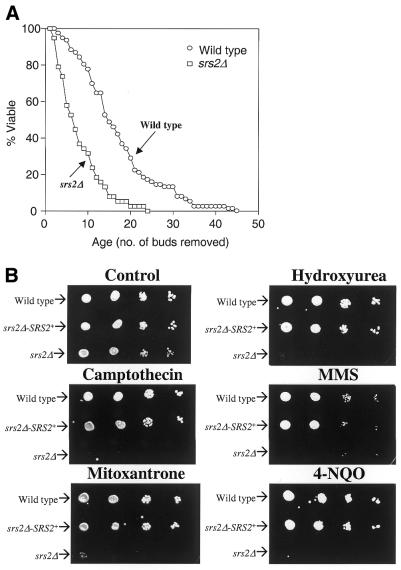Figure 1.
The diploid srs2Δ mutant has a shortened replicative lifespan and is sensitive to genotoxins. (A) Lifespan analysis. The srs2Δ and isogenic wild-type BY4743 diploid strains were transformed with YCplac33 vector and the replicative lifespan determined manually by micromanipulation. Individual cells were followed until they ceased dividing, and replicative age was defined as the number of buds removed from a mother cell. The survivorship curve shows the percentage of the population of yeast cells that is viable plotted against replicative age. Average lifespan of the strains (expressed as mean number of buds removed ± SEM) was 16 ± 1.0 (n = 76) for the BY4743-YCplac33 strain and 7.2 ± 0.9 for the srs2Δ-YCplac33 strain (n = 38). Maximum lifespans recorded were 44 and 23, respectively. (B) Genotoxin sensitivity. Strains were grown up, diluted and serially spotted out onto solid media plates containing various drugs. Plates were left for 3–4 days at 30°C. Cell spots (from left to right) correspond to serial 1 in 10 dilutions of cells (starting, furthest left, with OD600 = 0.33). The diploid strains compared were srs2Δ-YCplac33 (srs2Δ), srs2Δ-YCplac33-SRS2 (srs2Δ-SRS2+) and the wild-type control, BY4743-YCplac33 (BY4743). Drug doses used were as follows: 50 mM hydroxyurea, 0.33 mM camptothecin, 0.0066% MMS, 1 mM mitoxantrone and 0.5 µM 4-NQO.

